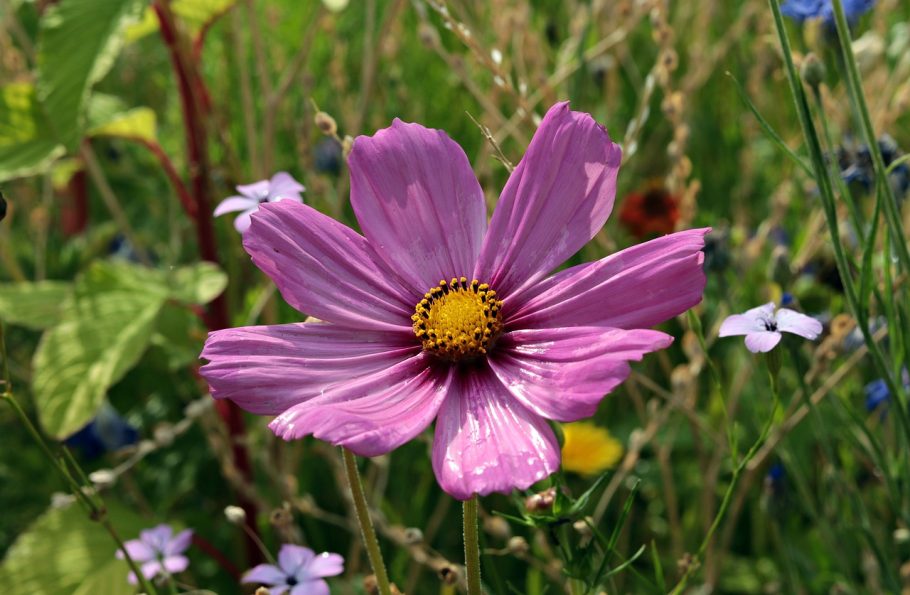Violet flowers have held great spiritual significance for centuries. In many cultures, they symbolize humility, introspection, and spiritual purity. Historically, violet flowers have been associated with religious and spiritual practices, particularly in ancient Greece and medieval Europe.
Violet flowers are not only a symbol of spirituality, but also of healing. Aromatherapists use essential oils from violets to promote relaxation and soothe nerves. Additionally, violet flowers have been used in traditional medicine to treat respiratory problems and skin irritations.
The significance of violet flowers is not limited to the spiritual and healing realms. They have also been used as symbols of love, romance, and aristocracy. In Japan, violet flowers represent the samurai warrior code and are associated with the country’s ancient aristocracy. In Victorian England, different colors of violet flowers were exchanged as romantic gestures, each with its own specific meaning.
Violet flowers have been popular subjects in art and literature, evoking themes of beauty, love, and spirituality. From Shakespeare’s Hamlet to Van Gogh’s paintings, violets have captured the imagination of artists throughout history.
Overall, the power of violet flowers is undeniable. Whether used in spiritual practices, aromatherapy, or as romantic gestures, they continue to hold a mystical and spiritual significance that has been recognized by cultures throughout history.
The History of Violet Symbolism
Violet flowers have been used for spiritual and religious purposes for many centuries. The ancient Greeks and medieval Europe both regarded violet flowers as symbols of humility, introspection, and spiritual purity. These flowers were often used in religious ceremonies and were seen as a way to connect with the divine.
Violet flowers were also associated with humility, which was considered a virtue in many cultures. The delicate and unassuming nature of the violet was seen as a symbol of humility, reminding people to remain humble in the face of adversity. This symbolism was often reflected in religious texts and art throughout history.
In addition to their spiritual symbolism, violet flowers were also popular for their healing properties. Aromatherapists believe that violet essential oils can promote relaxation and reduce stress. These flowers were also used in traditional medicine to treat respiratory problems and skin irritations.
Overall, the history of violet symbolism is rich and varied. From their use in religious ceremonies to their healing properties, violet flowers have been a powerful symbol throughout history. By embracing the mystical and spiritual meanings behind these flowers, we can bring a sense of tranquility and peace into our daily lives.
Violet Flowers in Mythology
Violet flowers have held symbolic value in various mythologies and religions throughout history. According to Greek mythology, the goddess Persephone had been picking violets when the god Hades abducted her to the underworld. In Christianity, violet is associated with the Virgin Mary and commonly used during the season of Lent.
These two examples highlight the diverse meanings and interpretations of violet flowers across different cultures and beliefs. While Persephone’s violet bouquet represents the transition into the underworld, the violet color in Christian tradition may symbolize penance and mourning.
Overall, violet flowers have been deeply ingrained in both ancient and modern cultural symbolism, enhancing their mystery and allure. The meanings and interpretations of violet flowers can vary widely, and their symbolic value often influenced by the context in which they are used.
The Healing Properties of Violets
Aside from their spiritual and symbolic meanings, violet flowers are also believed to have healing properties. In aromatherapy, violet essential oils are used to soothe the nerves and promote relaxation. Its sweet and mild scent is said to have a calming effect on the mind and body, making it a popular ingredient in massage oils and bath salts.
In traditional medicine, violets have been used for centuries to treat respiratory problems, such as asthma and bronchitis. It was also believed to be an effective treatment for skin irritations, including eczema and acne. Violet leaves were often used to make poultices and compresses, while the flowers themselves were made into teas and tonics that were ingested orally.
While the scientific evidence supporting the healing properties of violets is limited, their use in traditional medicine and aromatherapy continues to this day. Many people believe in the healing power of plants and flowers and use them as alternative treatments for various ailments.
The Symbolic Colors of Violet Flowers
Violet flowers, known for their beautiful and unique colors, have a symbolic meaning that goes beyond their aesthetic beauty. Violet flowers can come in a variety of shades, and each shade has its own significant and unique symbolic meaning. According to tradition, lighter shades of violet represent innocence, tranquility, and humility, while darker shades of violet can reflect spirituality and intuition.
Lighter shades of violet often represent purity and simplicity. The color of these flowers symbolizes the calming and peaceful effect of nature, particularly in times of spiritual reflection and meditative practices. It represents a sense of rebirth and new beginnings, as the color purple is associated with transformation in Eastern spiritual traditions.
On the other hand, darker shades of violet can reflect deeper spiritual meanings, such as higher consciousness and intuition. It represents aspects of the spiritual realm that are beyond comprehension yet are deeply felt, hence the color’s association with the mystical and divine. In some cultures, darker shades of violet are also associated with royalty and nobility.
Overall, violet flowers represent a powerful symbol of spirituality and inner peace. The different shades of violet convey different meanings that can help us understand and connect with our deepest selves. By embracing the symbolic meanings behind these beautiful flowers, we can bring a sense of tranquility and spiritual depth to our lives.
Violet Flowers in Art and Literature
Hamlet to Van Gogh’s paintings, violet flowers have been used to evoke themes of love, beauty, and spirituality. In Shakespeare’s Hamlet, Ophelia’s madness is linked to her obsession with violets, which she hands out to other characters as she descends into madness. Violet flowers have also been popular in Impressionist art, with painters like Vincent van Gogh using them in their works to convey a sense of beauty and spirituality. In literature and poetry, violet flowers often hold a romantic connotation, symbolizing love, faithfulness, and devotion. Overall, the use of violet flowers in art and literature showcases their enduring cultural significance and their ability to evoke emotions and themes that have resonated throughout history.
Hamlet
is one of the most famous plays ever written, and violet flowers play a symbolic role in this masterpiece of English literature. In the play, Ophelia, one of the main characters, hands out flowers to each of the characters as a way of conveying hidden messages. When she offers a violet to Hamlet, she is attempting to communicate that she is faithful and true to him. However, Hamlet rejects her gesture and the violet, perhaps symbolizing his own grief and anger. The use of violet flowers in Hamlet illustrates the power of symbolism in literature and how it can convey complex emotions and meanings.
Violet flowers have a long history of being used as a symbol of love, beauty, and spirituality in art and literature. Famous artists like Van Gogh have used violet flowers in their paintings to evoke these themes. Shakespeare’s Hamlet also references violet flowers as a symbol of love and innocence. In addition to their beauty, the spiritual significance of violet flowers has been recognized by cultures throughout history. They are often associated with introspection, humility, and spiritual purity. The various shades of violet flowers can also carry their own symbolic meanings, from lighter shades representing tranquility to darker shades representing intuition and spirituality. Overall, the use of violet flowers in art and literature serves not only to beautify the world around us, but also to connect us to deeper spiritual meanings and themes.
The Cultural Significance of Violets
In many cultures around the world, violet flowers carry significant symbolism and hold special meanings. They have been used as a symbol of nobility, beauty, and love in different societies throughout history. In Japan, violet flowers are associated with the samurai warrior code and were seen as a symbol of the country’s ancient aristocracy. They were often used in samurai armor and clothing as a symbol of honor and respect.
In Victorian England, violet flowers were exchanged as a romantic gesture, with each color having its own specific meaning. A bouquet of light violet flowers symbolized innocence and purity, while darker shades represented loyalty and devotion. In some cultures, violet flowers also represent royalty and power, and were often used in regal ceremonies and events.
Overall, the cultural significance of violet flowers varies depending on the society and context in which they are used. However, their deep and mystical meanings have been recognized by people throughout history, making them a beloved symbol of spiritual and emotional purity.
The Spiritual Power of Violet Flowers
Violet flowers possess a powerful spiritual energy that has been recognized and valued throughout history. The use of violet flowers as symbols of spiritual purity, introspection, and humility can be seen in many cultures and religions around the world. Additionally, the healing properties of violets have been utilized in various forms of traditional medicine and aromatherapy to soothe the nerves and promote relaxation.
Furthermore, the different shades of violet flowers like lighter shades symbolize innocence and tranquility while the darker shades symbolize spiritual awareness and intuition. In art and literature, violet flowers have been a popular subject for centuries, evoking themes of love, beauty, and spirituality. In many cultures, violets are associated with ancient aristocracy, chivalry, and romantic love.
To embrace the spiritual power of violet flowers, it is important to understand their deep symbolic meanings in different contexts. Whether appreciated for their beauty, healing properties, or spiritual symbolism, violet flowers can enhance our lives and add a sense of peace and tranquility.





